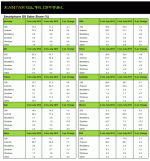
The latest smartphone sales figures are out today from Kantar WorldPanel Comtech, and in case you needed one more metric to underscore the topline trend that’s been the case for years, the WPP market-research analysts are giving it to you: led by Samsung, Android accounted for 70% of all smartphone sales in the biggest markets in Europe and China for the 12-week period to the end of July. Apple, meanwhile, is an increasingly mixed picture, with shares as low as 6% in one country, Spain, and as high as 43% in the U.S. Interestingly, Kantar’s figures also highlight another important trend. Microsoft’s Windows Phone OS — and by association its biggest partner, Nokia — continues to gain ground, if slowly. It nudged up to 3.5% of sales in the U.S., and in Europe, it has nearly doubled its share in the last year and is now at 8.2% of sales.
It’s not all rosy for Windows Phone, though: in China, its already-tiny share halved over a year ago, and it’s now at just 2.2% of sales.
Dumbphones but not a dumb strategy
Kantar points out an interesting trend in how Windows Phone is growing. While Android and Apple’s iOS platform picked up a lot of speed by tapping smartphone users from Symbian and BlackBerry looking for something more dynamic, Windows Phone appears to be finding new people from somewhere else: the still-large amount of feature phone users in the world, with 42% of sales coming from those making their first moves off feature phones.
That’s a smart move: according to Gartner’s figures, feature phones (AKA dumbphones) still account for 48.2% of all mobile handset sales in Q3. These consumers are less likely to be entrenched in an existing smartphone platform. “27% of Apple and Android users change their OS when they replace their handset,” writes Dominic Sunnebo, an analyst with Kantar.
It will be interesting to see whether Windows Phone manages to pick up mindshare along with marketshare; or whether we finally start to see that success in one does not necessarily lead to success in the other. As Sunnebo points out, “Android and Apple take the lion’s share of the headlines and continue to dominate smartphone sales, so it’s easy to forget that there is a third operating system emerging as a real adversary.”
He points out that low-price models like the Lumia 520 now represents around one in 10 smartphone sales in Britain, France, Germany and Mexico. ”For the first time the platform has claimed the number two spot in a major world market, taking 11.6% of sales in Mexico,” he notes.
Among the other players, BlackBerry continues to languish and one wonders how a player that has all but disappeared will manage to claw back, strategic resolve to embrace “niche” or not. In the “big five” markets in Europe of the UK, France, Germany, Italy and Spain, BlackBerry now accounts for 2.4% of sales; in the U.S. its share is now 1.2% of sales.
The golden Apple?
Kantar’s figures are an interesting counterbalance to figures from analysts like IDC, Gartner and Strategy Analytics, which chart shipments from handset makers (and therefore may be overshooting or undershooting how many consumers users are actually buying). And indeed there is a disparity: Kantar, a WPP-owned market research firm, says that worldwide Android accounted for 70% of sales in the 12 weeks to the end of July. In comparison, Gartner and Strategy Analytics both noted recently that Android took nearly 80% of smartphone sales in Q3.
Regardless of specific percentages, all of these analysts’ figures point to a very huge and now pretty established smartphone leader in the form of Google’s OS, and specifically how it is used by Samsung.
We’re reaching out to Kantar to try to get an exact proportion of sales for Samsung specifically, as well as Android globally. What this trend also does is set the stage to see how the market responds to the all-but-confirmed introduction of some new, and possibly price-busting iPhone models from Apple.
The full table below:
Image: Flickr


